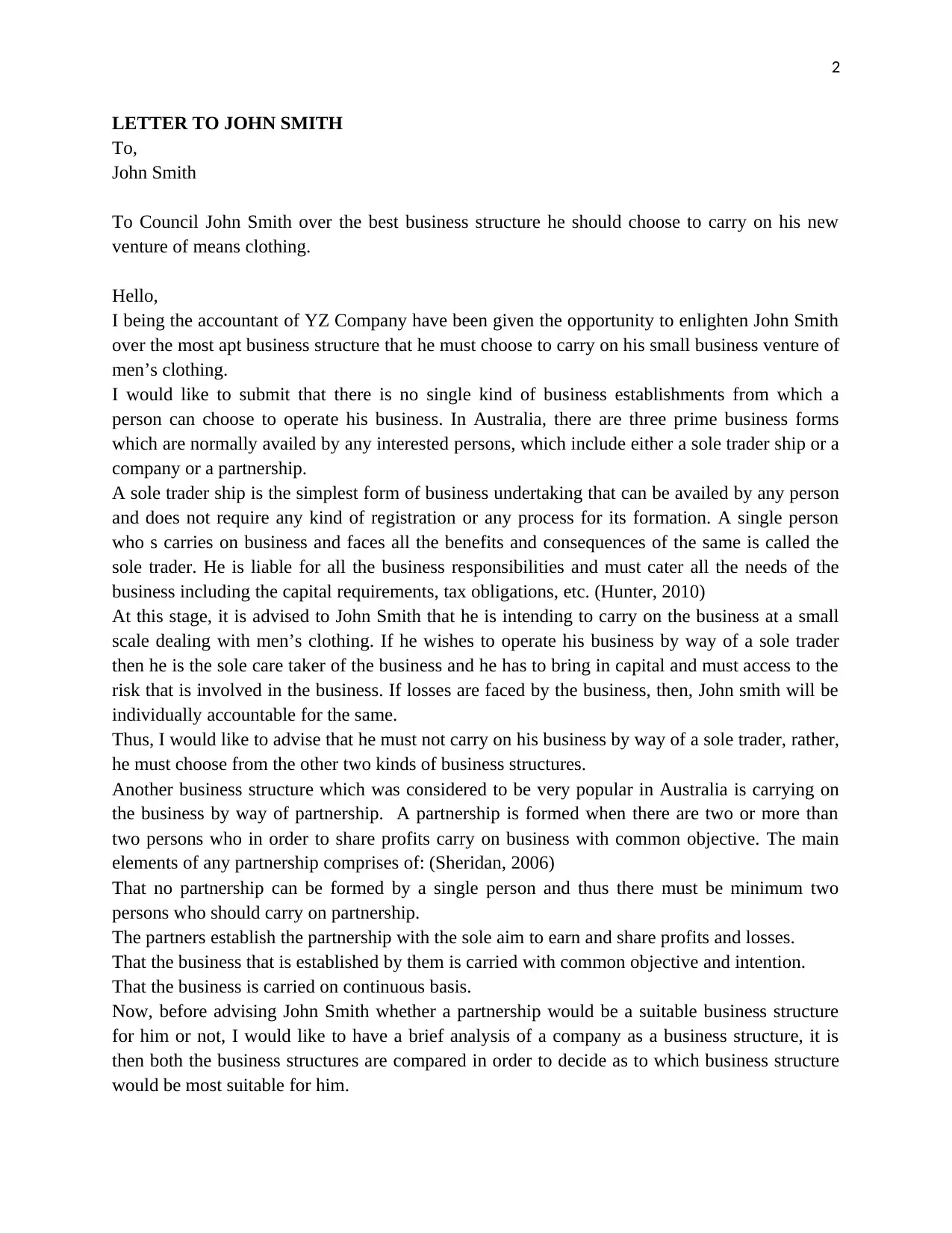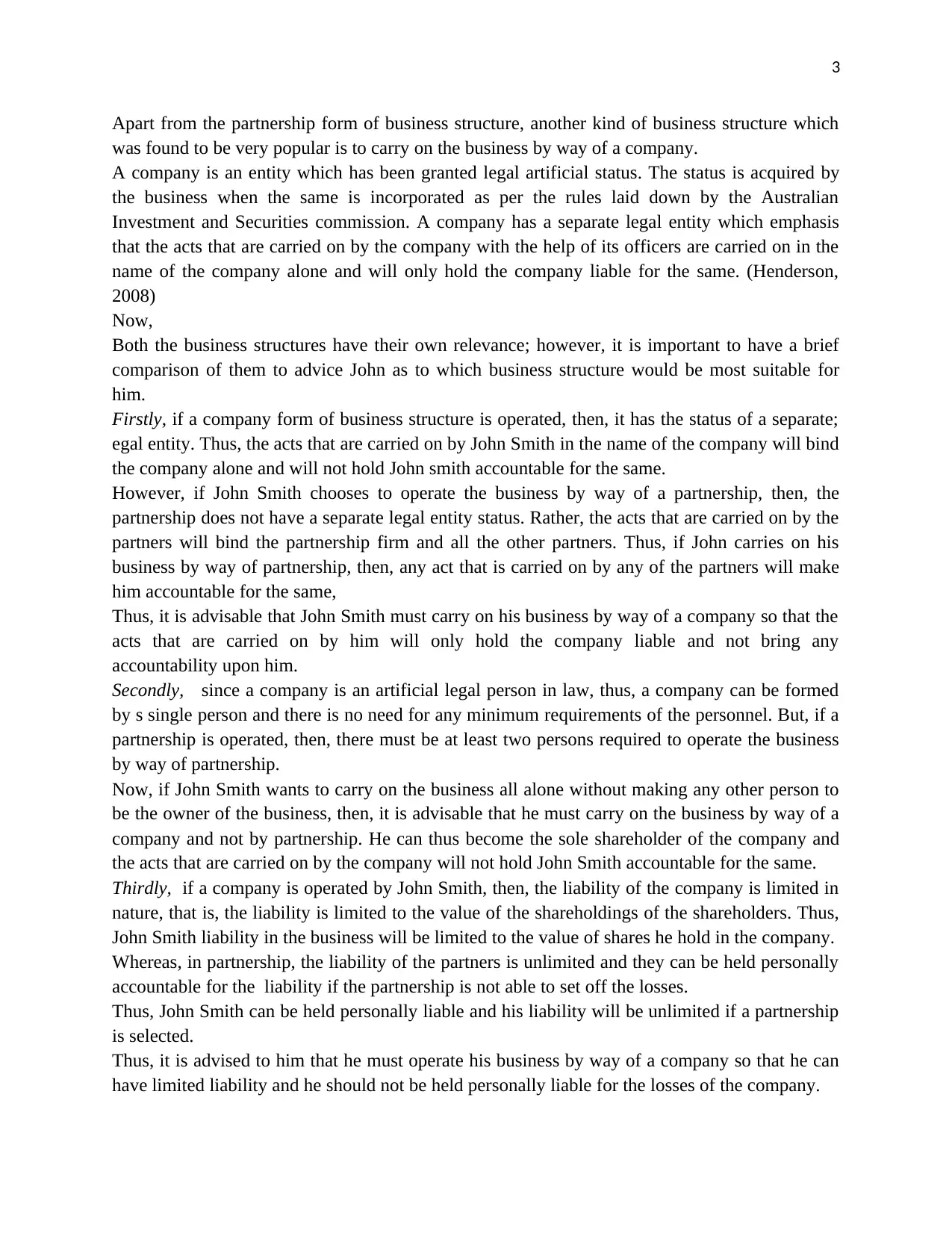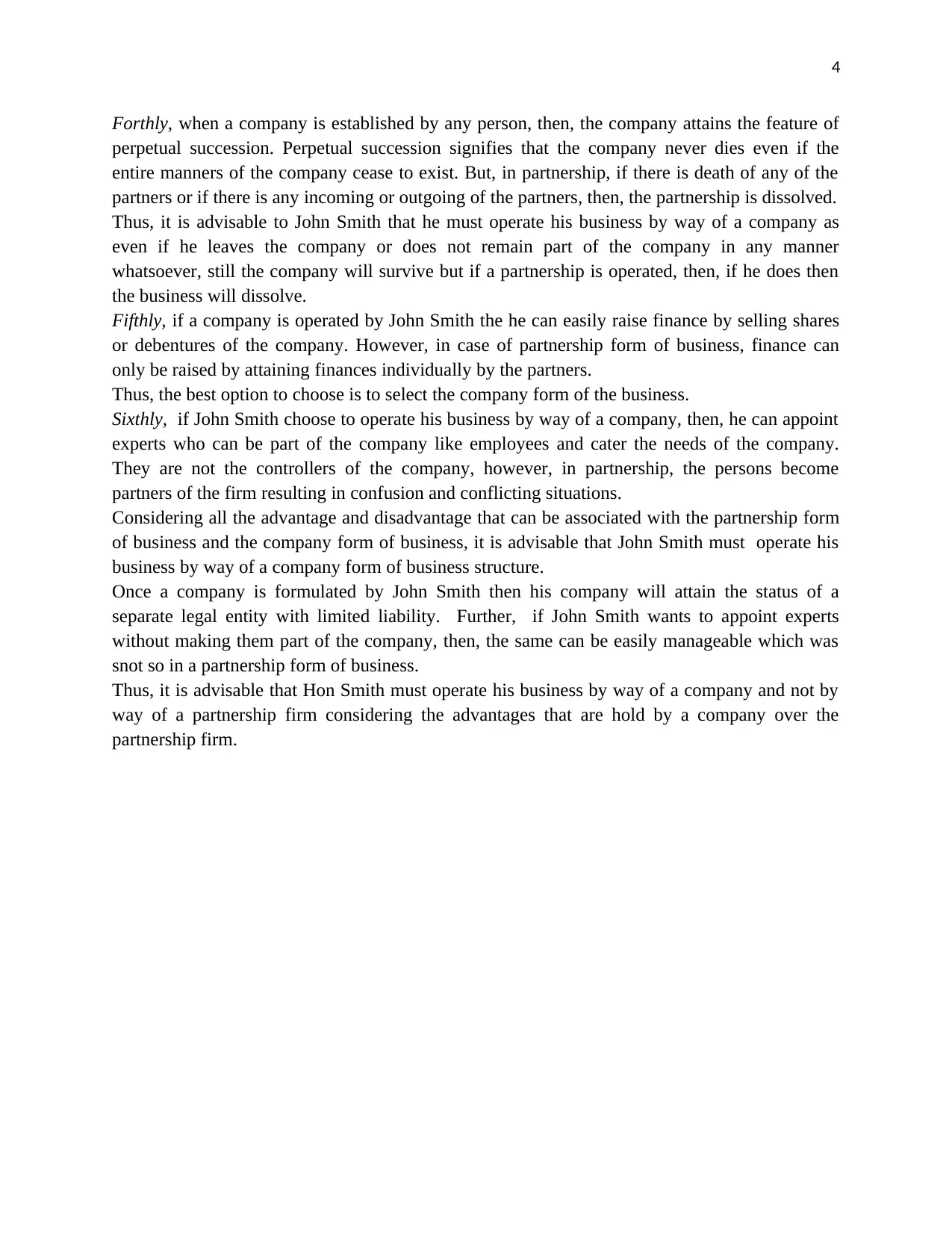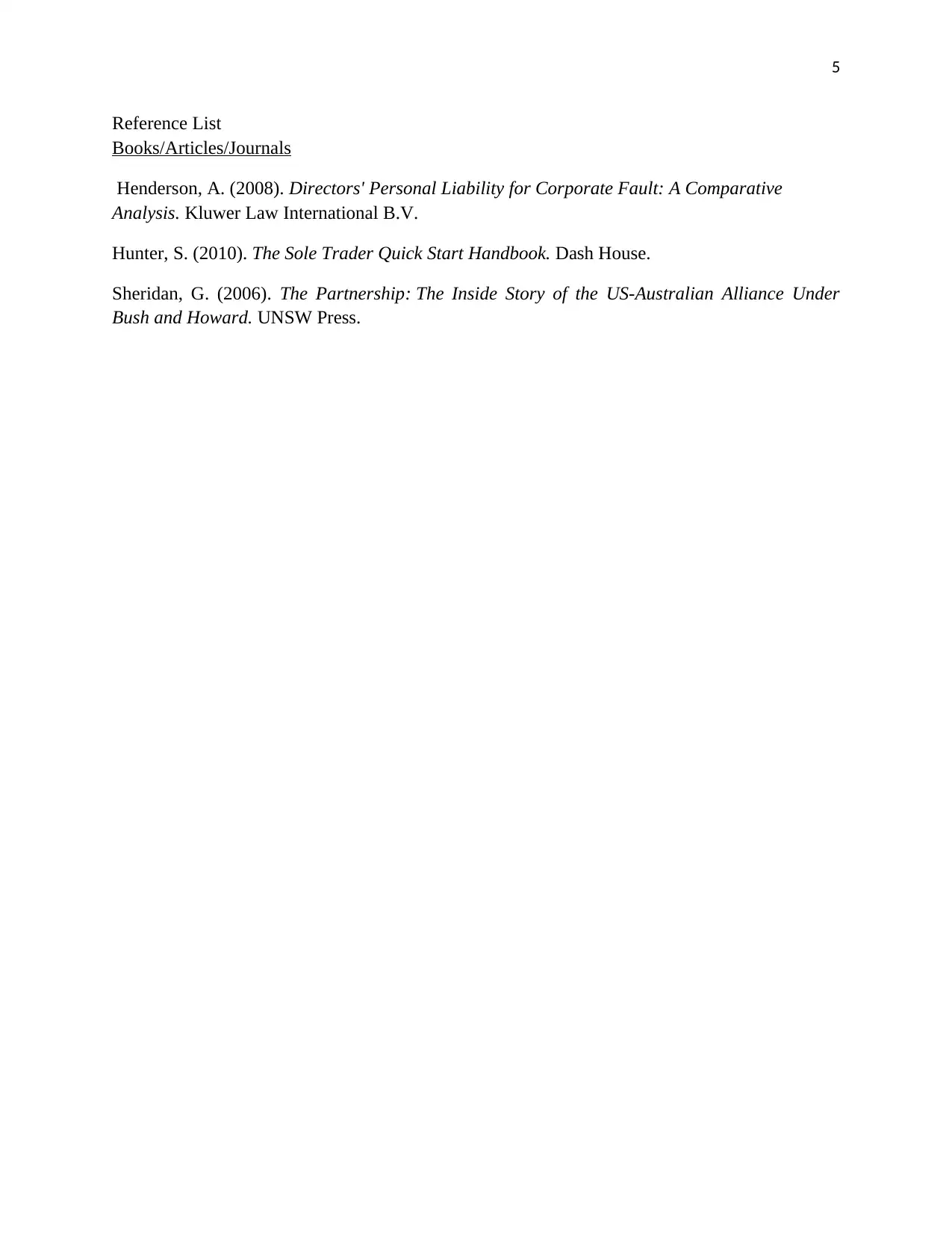LAW200 Commercial Law Assignment: Business Structure Advice Letter
VerifiedAdded on 2022/11/13
|5
|1670
|213
Report
AI Summary
This assignment is a letter providing legal and business structure advice to a client named John Smith, who is starting a men's clothing business. The letter, written from the perspective of an accountant, explores the three primary business structures available in Australia: sole trader, partnership, and company. It details the advantages and disadvantages of each structure, including liability, capital requirements, and legal entity status. The letter recommends that John Smith should operate his business by way of a company due to its separate legal entity status, limited liability, perpetual succession, and ease of raising finance. The assignment compares the business structures to help John Smith make an informed decision about the most suitable form for his new venture, emphasizing the benefits of a company structure, especially in terms of liability and financial flexibility. The letter concludes by advising John to adopt a company structure for his business.

1
Contents
LETTER TO JOHN SMITH...........................................................................................................2
Reference List..................................................................................................................................5
Contents
LETTER TO JOHN SMITH...........................................................................................................2
Reference List..................................................................................................................................5
Paraphrase This Document
Need a fresh take? Get an instant paraphrase of this document with our AI Paraphraser

2
LETTER TO JOHN SMITH
To,
John Smith
To Council John Smith over the best business structure he should choose to carry on his new
venture of means clothing.
Hello,
I being the accountant of YZ Company have been given the opportunity to enlighten John Smith
over the most apt business structure that he must choose to carry on his small business venture of
men’s clothing.
I would like to submit that there is no single kind of business establishments from which a
person can choose to operate his business. In Australia, there are three prime business forms
which are normally availed by any interested persons, which include either a sole trader ship or a
company or a partnership.
A sole trader ship is the simplest form of business undertaking that can be availed by any person
and does not require any kind of registration or any process for its formation. A single person
who s carries on business and faces all the benefits and consequences of the same is called the
sole trader. He is liable for all the business responsibilities and must cater all the needs of the
business including the capital requirements, tax obligations, etc. (Hunter, 2010)
At this stage, it is advised to John Smith that he is intending to carry on the business at a small
scale dealing with men’s clothing. If he wishes to operate his business by way of a sole trader
then he is the sole care taker of the business and he has to bring in capital and must access to the
risk that is involved in the business. If losses are faced by the business, then, John smith will be
individually accountable for the same.
Thus, I would like to advise that he must not carry on his business by way of a sole trader, rather,
he must choose from the other two kinds of business structures.
Another business structure which was considered to be very popular in Australia is carrying on
the business by way of partnership. A partnership is formed when there are two or more than
two persons who in order to share profits carry on business with common objective. The main
elements of any partnership comprises of: (Sheridan, 2006)
That no partnership can be formed by a single person and thus there must be minimum two
persons who should carry on partnership.
The partners establish the partnership with the sole aim to earn and share profits and losses.
That the business that is established by them is carried with common objective and intention.
That the business is carried on continuous basis.
Now, before advising John Smith whether a partnership would be a suitable business structure
for him or not, I would like to have a brief analysis of a company as a business structure, it is
then both the business structures are compared in order to decide as to which business structure
would be most suitable for him.
LETTER TO JOHN SMITH
To,
John Smith
To Council John Smith over the best business structure he should choose to carry on his new
venture of means clothing.
Hello,
I being the accountant of YZ Company have been given the opportunity to enlighten John Smith
over the most apt business structure that he must choose to carry on his small business venture of
men’s clothing.
I would like to submit that there is no single kind of business establishments from which a
person can choose to operate his business. In Australia, there are three prime business forms
which are normally availed by any interested persons, which include either a sole trader ship or a
company or a partnership.
A sole trader ship is the simplest form of business undertaking that can be availed by any person
and does not require any kind of registration or any process for its formation. A single person
who s carries on business and faces all the benefits and consequences of the same is called the
sole trader. He is liable for all the business responsibilities and must cater all the needs of the
business including the capital requirements, tax obligations, etc. (Hunter, 2010)
At this stage, it is advised to John Smith that he is intending to carry on the business at a small
scale dealing with men’s clothing. If he wishes to operate his business by way of a sole trader
then he is the sole care taker of the business and he has to bring in capital and must access to the
risk that is involved in the business. If losses are faced by the business, then, John smith will be
individually accountable for the same.
Thus, I would like to advise that he must not carry on his business by way of a sole trader, rather,
he must choose from the other two kinds of business structures.
Another business structure which was considered to be very popular in Australia is carrying on
the business by way of partnership. A partnership is formed when there are two or more than
two persons who in order to share profits carry on business with common objective. The main
elements of any partnership comprises of: (Sheridan, 2006)
That no partnership can be formed by a single person and thus there must be minimum two
persons who should carry on partnership.
The partners establish the partnership with the sole aim to earn and share profits and losses.
That the business that is established by them is carried with common objective and intention.
That the business is carried on continuous basis.
Now, before advising John Smith whether a partnership would be a suitable business structure
for him or not, I would like to have a brief analysis of a company as a business structure, it is
then both the business structures are compared in order to decide as to which business structure
would be most suitable for him.

3
Apart from the partnership form of business structure, another kind of business structure which
was found to be very popular is to carry on the business by way of a company.
A company is an entity which has been granted legal artificial status. The status is acquired by
the business when the same is incorporated as per the rules laid down by the Australian
Investment and Securities commission. A company has a separate legal entity which emphasis
that the acts that are carried on by the company with the help of its officers are carried on in the
name of the company alone and will only hold the company liable for the same. (Henderson,
2008)
Now,
Both the business structures have their own relevance; however, it is important to have a brief
comparison of them to advice John as to which business structure would be most suitable for
him.
Firstly, if a company form of business structure is operated, then, it has the status of a separate;
egal entity. Thus, the acts that are carried on by John Smith in the name of the company will bind
the company alone and will not hold John smith accountable for the same.
However, if John Smith chooses to operate the business by way of a partnership, then, the
partnership does not have a separate legal entity status. Rather, the acts that are carried on by the
partners will bind the partnership firm and all the other partners. Thus, if John carries on his
business by way of partnership, then, any act that is carried on by any of the partners will make
him accountable for the same,
Thus, it is advisable that John Smith must carry on his business by way of a company so that the
acts that are carried on by him will only hold the company liable and not bring any
accountability upon him.
Secondly, since a company is an artificial legal person in law, thus, a company can be formed
by s single person and there is no need for any minimum requirements of the personnel. But, if a
partnership is operated, then, there must be at least two persons required to operate the business
by way of partnership.
Now, if John Smith wants to carry on the business all alone without making any other person to
be the owner of the business, then, it is advisable that he must carry on the business by way of a
company and not by partnership. He can thus become the sole shareholder of the company and
the acts that are carried on by the company will not hold John Smith accountable for the same.
Thirdly, if a company is operated by John Smith, then, the liability of the company is limited in
nature, that is, the liability is limited to the value of the shareholdings of the shareholders. Thus,
John Smith liability in the business will be limited to the value of shares he hold in the company.
Whereas, in partnership, the liability of the partners is unlimited and they can be held personally
accountable for the liability if the partnership is not able to set off the losses.
Thus, John Smith can be held personally liable and his liability will be unlimited if a partnership
is selected.
Thus, it is advised to him that he must operate his business by way of a company so that he can
have limited liability and he should not be held personally liable for the losses of the company.
Apart from the partnership form of business structure, another kind of business structure which
was found to be very popular is to carry on the business by way of a company.
A company is an entity which has been granted legal artificial status. The status is acquired by
the business when the same is incorporated as per the rules laid down by the Australian
Investment and Securities commission. A company has a separate legal entity which emphasis
that the acts that are carried on by the company with the help of its officers are carried on in the
name of the company alone and will only hold the company liable for the same. (Henderson,
2008)
Now,
Both the business structures have their own relevance; however, it is important to have a brief
comparison of them to advice John as to which business structure would be most suitable for
him.
Firstly, if a company form of business structure is operated, then, it has the status of a separate;
egal entity. Thus, the acts that are carried on by John Smith in the name of the company will bind
the company alone and will not hold John smith accountable for the same.
However, if John Smith chooses to operate the business by way of a partnership, then, the
partnership does not have a separate legal entity status. Rather, the acts that are carried on by the
partners will bind the partnership firm and all the other partners. Thus, if John carries on his
business by way of partnership, then, any act that is carried on by any of the partners will make
him accountable for the same,
Thus, it is advisable that John Smith must carry on his business by way of a company so that the
acts that are carried on by him will only hold the company liable and not bring any
accountability upon him.
Secondly, since a company is an artificial legal person in law, thus, a company can be formed
by s single person and there is no need for any minimum requirements of the personnel. But, if a
partnership is operated, then, there must be at least two persons required to operate the business
by way of partnership.
Now, if John Smith wants to carry on the business all alone without making any other person to
be the owner of the business, then, it is advisable that he must carry on the business by way of a
company and not by partnership. He can thus become the sole shareholder of the company and
the acts that are carried on by the company will not hold John Smith accountable for the same.
Thirdly, if a company is operated by John Smith, then, the liability of the company is limited in
nature, that is, the liability is limited to the value of the shareholdings of the shareholders. Thus,
John Smith liability in the business will be limited to the value of shares he hold in the company.
Whereas, in partnership, the liability of the partners is unlimited and they can be held personally
accountable for the liability if the partnership is not able to set off the losses.
Thus, John Smith can be held personally liable and his liability will be unlimited if a partnership
is selected.
Thus, it is advised to him that he must operate his business by way of a company so that he can
have limited liability and he should not be held personally liable for the losses of the company.
⊘ This is a preview!⊘
Do you want full access?
Subscribe today to unlock all pages.

Trusted by 1+ million students worldwide

4
Forthly, when a company is established by any person, then, the company attains the feature of
perpetual succession. Perpetual succession signifies that the company never dies even if the
entire manners of the company cease to exist. But, in partnership, if there is death of any of the
partners or if there is any incoming or outgoing of the partners, then, the partnership is dissolved.
Thus, it is advisable to John Smith that he must operate his business by way of a company as
even if he leaves the company or does not remain part of the company in any manner
whatsoever, still the company will survive but if a partnership is operated, then, if he does then
the business will dissolve.
Fifthly, if a company is operated by John Smith the he can easily raise finance by selling shares
or debentures of the company. However, in case of partnership form of business, finance can
only be raised by attaining finances individually by the partners.
Thus, the best option to choose is to select the company form of the business.
Sixthly, if John Smith choose to operate his business by way of a company, then, he can appoint
experts who can be part of the company like employees and cater the needs of the company.
They are not the controllers of the company, however, in partnership, the persons become
partners of the firm resulting in confusion and conflicting situations.
Considering all the advantage and disadvantage that can be associated with the partnership form
of business and the company form of business, it is advisable that John Smith must operate his
business by way of a company form of business structure.
Once a company is formulated by John Smith then his company will attain the status of a
separate legal entity with limited liability. Further, if John Smith wants to appoint experts
without making them part of the company, then, the same can be easily manageable which was
snot so in a partnership form of business.
Thus, it is advisable that Hon Smith must operate his business by way of a company and not by
way of a partnership firm considering the advantages that are hold by a company over the
partnership firm.
Forthly, when a company is established by any person, then, the company attains the feature of
perpetual succession. Perpetual succession signifies that the company never dies even if the
entire manners of the company cease to exist. But, in partnership, if there is death of any of the
partners or if there is any incoming or outgoing of the partners, then, the partnership is dissolved.
Thus, it is advisable to John Smith that he must operate his business by way of a company as
even if he leaves the company or does not remain part of the company in any manner
whatsoever, still the company will survive but if a partnership is operated, then, if he does then
the business will dissolve.
Fifthly, if a company is operated by John Smith the he can easily raise finance by selling shares
or debentures of the company. However, in case of partnership form of business, finance can
only be raised by attaining finances individually by the partners.
Thus, the best option to choose is to select the company form of the business.
Sixthly, if John Smith choose to operate his business by way of a company, then, he can appoint
experts who can be part of the company like employees and cater the needs of the company.
They are not the controllers of the company, however, in partnership, the persons become
partners of the firm resulting in confusion and conflicting situations.
Considering all the advantage and disadvantage that can be associated with the partnership form
of business and the company form of business, it is advisable that John Smith must operate his
business by way of a company form of business structure.
Once a company is formulated by John Smith then his company will attain the status of a
separate legal entity with limited liability. Further, if John Smith wants to appoint experts
without making them part of the company, then, the same can be easily manageable which was
snot so in a partnership form of business.
Thus, it is advisable that Hon Smith must operate his business by way of a company and not by
way of a partnership firm considering the advantages that are hold by a company over the
partnership firm.
Paraphrase This Document
Need a fresh take? Get an instant paraphrase of this document with our AI Paraphraser

5
Reference List
Books/Articles/Journals
Henderson, A. (2008). Directors' Personal Liability for Corporate Fault: A Comparative
Analysis. Kluwer Law International B.V.
Hunter, S. (2010). The Sole Trader Quick Start Handbook. Dash House.
Sheridan, G. (2006). The Partnership: The Inside Story of the US-Australian Alliance Under
Bush and Howard. UNSW Press.
Reference List
Books/Articles/Journals
Henderson, A. (2008). Directors' Personal Liability for Corporate Fault: A Comparative
Analysis. Kluwer Law International B.V.
Hunter, S. (2010). The Sole Trader Quick Start Handbook. Dash House.
Sheridan, G. (2006). The Partnership: The Inside Story of the US-Australian Alliance Under
Bush and Howard. UNSW Press.
1 out of 5
Related Documents
Your All-in-One AI-Powered Toolkit for Academic Success.
+13062052269
info@desklib.com
Available 24*7 on WhatsApp / Email
![[object Object]](/_next/static/media/star-bottom.7253800d.svg)
Unlock your academic potential
Copyright © 2020–2025 A2Z Services. All Rights Reserved. Developed and managed by ZUCOL.





